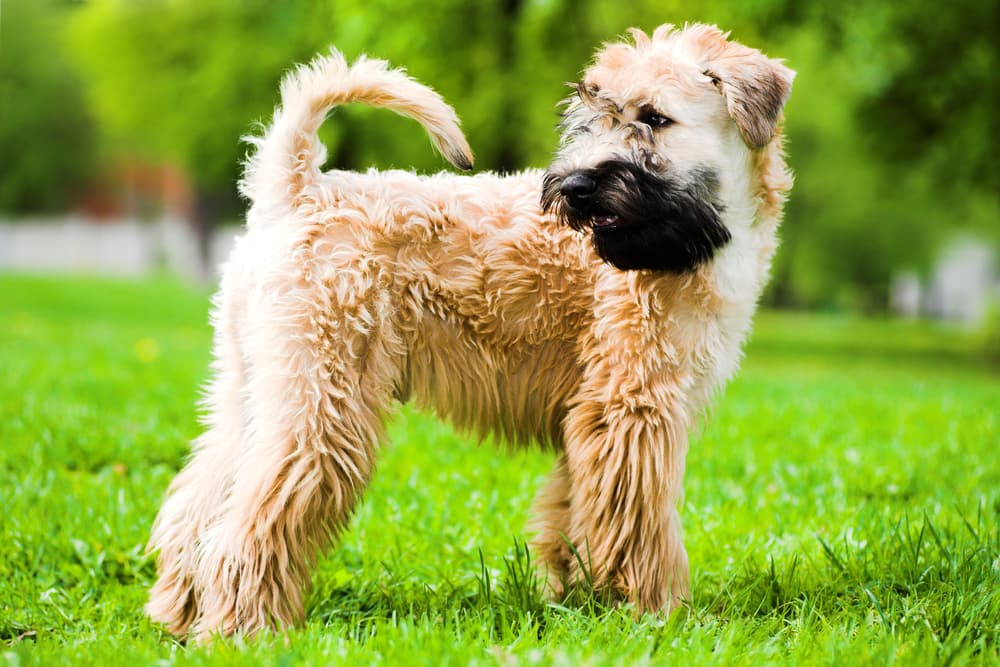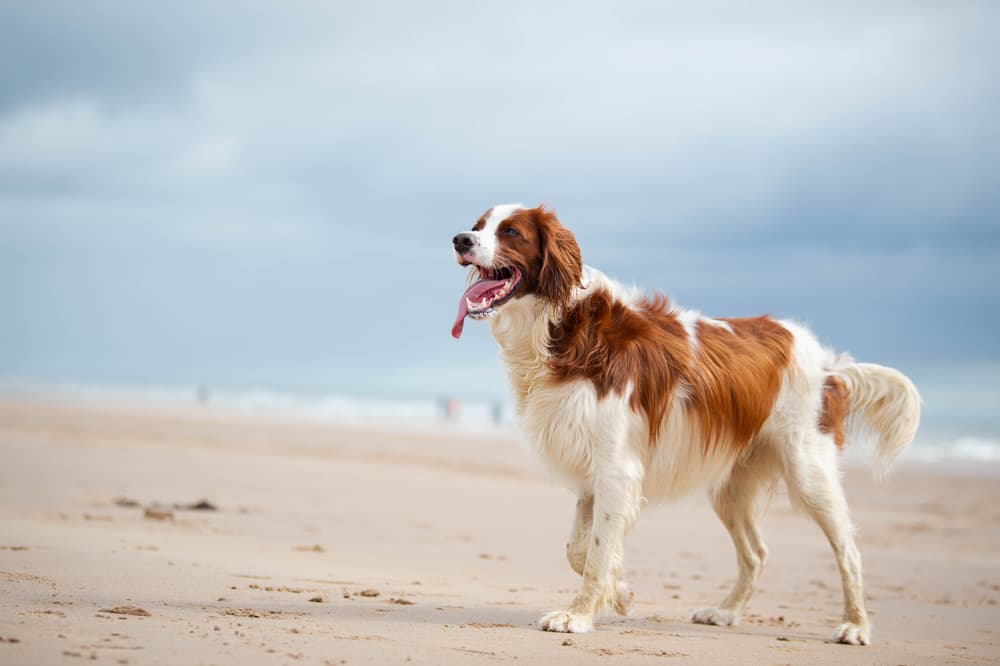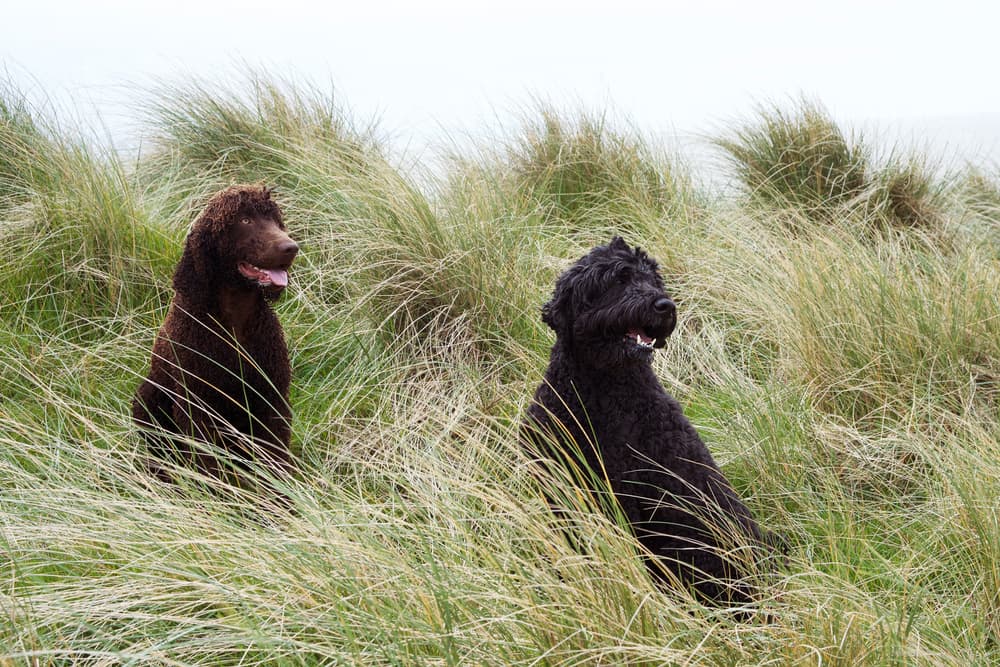8 Irish Dog Breeds Native to Ireland

Whether your family hails from the Emerald Isle and you’re looking for a canine to match or you’ve fallen in love with an Irish Setter or Wolfhound, there are so many reasons to celebrate the dogs of Ireland.
Here’s everything you need to know about Irish dog breeds including their history and heritage, physical appearance, grooming needs, and special considerations should you decide to add one to your family.
Irish Dogs: 8 Top Breeds
Consider this your quick guide to the top eight Irish dog breeds.
Irish Setter

Irish Setters are perhaps most famous for their graceful, elegant appearance with a rich chestnut coat and the muscular physique of a duck hunter. “They are an outgoing and affectionate breed that loves companionship,” says Gina DiNardo, executive secretary with the AKC, hence their status as a top-notch family dog always ready to rollick and play. However, “be prepared to train a high-energy dog that needs space to run,” says DiNardo. Setters take about 3 years to mature to adulthood, and their long, flat coat requires regular brushing at least 2-3 times a week.
Kerry Blue Terrier

Named after the Irish county they hail from, Kerry Blue Terriers were raised to “hunt small game, herd sheep and cattle, be a watchdog, and provide companionship,” says DiNardo. They sport a beautiful blue-gray curly coat and impressively large beard and mustache. Kerry Blues generally love their people but are less likely to get along with other dogs or small pets. Since they don’t shed much, they require weekly brushing and combing to avoid mats and grooming every 6 to 8 weeks.
Irish Terrier

With perky ears, a medium-sized build, and wirey wheat to red-colored coat, Irish Terriers have served as hard-working farm dogs in Ireland and beyond for centuries. “Breed fanciers appreciate their confident and curious personality, as well as the strong bonds they form with those closest to them,” says Dr. Linda Simon, a U.K.-based veterinarian. They’re known for having a stubborn, independent streak and were built for endurance, so it’s important to start training early, keep it up long-term, and give them plenty of space to run. They do best in a single-dog household and need their coats brushed and stripped (meaning hand-pulled by a groomer) rather than clipped.
Soft Coated Wheaten Terrier

“The Soft Coated Wheaten Terrier is a delightfully joyful breed that is less intense than most Terrier breeds,” says Emily Holden, a breeder based in Dauphin County, Pennsylvania. “But be prepared for Terrier traits like stubbornness.” Raised to be an all-purpose farm dog, Soft Coated Wheaten Terriers make for great companions and watchdogs. But since they’re so people-focused, early training and socialization are key. Their silky coat with a soft wave does come at a price: grooming with a pin brush or slicker brush as well as a full comb-through with a medium- and fine-toothed metal comb should be done every day to keep it mat-free.
Irish Water Spaniel

Known as the “clowns” of the Spaniel family, Irish Water Spaniels sport a Poodle-like curly coat with a shaggy bundle of curls or “topknot” on their head. “This is a rare breed, and many people will never have seen one in their lifetime,” says Dr. Simon. Bred to swim and hunt, they’re highly athletic and—in turn—require plenty of exercise (think: two hours outside each day to keep them calm at home). They need firm and consistent training and can be standoffish with other dogs or strangers. Coat upkeep requires regular water exposure, combing every 1 to 2 weeks, and scissoring every 6 to 8 weeks.
Glen of Imaal Terrier

Named after a valley in Ireland’s rugged Wicklow Mountains, Glens were raised to chase down badgers and help out on the farm. Like mini, stretched-out Irish Wolfhounds, they sport a no-nonsense look and low-maintenance wiry coat. While they “are not athletically gifted,” they do “enjoy keeping active and exploring whenever the opportunity arises,” says Dr. Simon. Typical of Terriers, they can be feisty, stubborn, and not so into other dogs, but they make a good addition to families with older children. They’re also adaptable to life in the country or city, says DiNardo. “They love a fenced-in yard to run, but be mindful as they can easily dig underneath it,” she notes.
Irish Red and White Setter

Since the 1600s, Red and Whites have been a feature of the Irish landscape. Their dappled appearance is key to help bird hunters spot them from far away. Shorter and stockier than their famous cousins the Red Setters, Red and Whites are a “friendly, sensitive, and eager-to-please breed that responds well to training,” says DiNardo. While their temperament makes them a great family dog, they’re high-energy field dogs at heart and need lots of running time. Weekly brushing is a must to avoid mats, and their floppy, heavy ears can be prone to infections after swimming, notes Dr. Simon. As such, special attention to drying ear canals after a swim is key.
Irish Wolfhound

It’s easy to fall in love with these big Irish dogs thanks to their sweet nature, huge gallop, and impressive size, weighing in at up to 180 pounds with a height of 30 inches or more. In the distant past, these hunters drove wolves and big game to extinction in Ireland, but these days, they’re far too serene to serve as guard dogs. Irish Wolfhounds are well-known for their intelligence, courage, and sensitivity, a winning combo for a therapy dog or beloved family pet.
However, “the very qualities that make Irish Wolfhounds unique and coveted can make them a challenge to live with,” says Dr. Melanie Mercer, director of the Irish Wolfhound Club of America board. Despite their gentle nature, their size and enthusiasm can result in bumps and bruises for small children, and like all giant breeds, they have an increased risk of health problems such as bone cancer and shortened lifespan of 6 to 8 years—which is why it’s essential to work with a trustworthy breeder.
Irish Dog Breed Facts

With such a long history, it’s no wonder Irish dog breeds have played key roles in society as well as legends and stories dating back centuries.
Here are a few of the most fascinating facts about these Irish dogs.
1. No one knows where Kerry Blue Terriers came from.
Their origins are unclear, but legend has it peasants developed the breed to poach from the nobility’s hunters, Irish Wolfhounds. Others say they came from a single blue dog that leapt from a Russian shipwreck or the Spanish Armada to mingle with Irish gals on shore.
2. The Irish Water Spaniel is likely the oldest Spaniel breed.
Their name has been referenced in Irish texts as early as the 1100s, and some evidence suggests these water-lovers may have been splashing around as far back as the 7th century AD.
3. For hundreds of years, Irish dogs were divided by class.
Sporting or hunting dogs were for rich men, while the poor were allowed to keep smaller, low-maintenance terriers.
4. Irish Setters are named for “setting down” on their bellies.
This is how they signal to their hunting companions they’ve found birds with their powerful noses.
5. The Glen of Imaal may have made for a special fireside helper.
Some say Glens once used their powerful back legs and bowed front legs to serve as “turnspit dogs.” Supposedly, they helped turn the spit over the hearth as one would rotate a rotisserie chicken by running on a contraption resembling a hamster wheel.
6. Irish Terriers served alongside soldiers in World War I.
Irish Terriers have been lauded for their role as smart and faithful messengers for troops during combat.
Famous Irish Dog Breeds

Many presidents and world leaders have had prized Irish companions over the years, but these canines are some of the most memorable for their bravery, kindness, and smarts.
Garryowen
Also known as Garry II, this Irish Setter could almost always be found at the side of the governor of Maine, Percival Proctor Baxter, from 1921-25. He inspired Baxter to send stray dogs to prisons to serve as companions for inmates, and on his death, the governor ordered the statehouse flag to be lowered to half staff in honor of his best friend.
Boatswain
This Irish Water Spaniel is considered the father of his breed, credited with passing down his pups their classic look. Rumor has it he lived to be 20 years old.
King Timahoe
President Richard Nixon’s Irish setter—named after his ancestors’ home in Ireland—was famous for his sweet tooth. A clip from NBC Evening News shows him scarfing down a piece of cake at Nixon’s 61st birthday party.
Gelert
As the legend goes, this loving Irish Wolfhound fought valiantly to save a baby from being devoured by a wolf. But when his owner came home to find his baby missing, he assumed Gelert hurt the child and killed him—only to realize afterward, upon hearing his baby’s cries, that his dog had in fact protected the child before his tragic demise.









